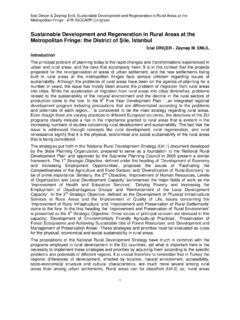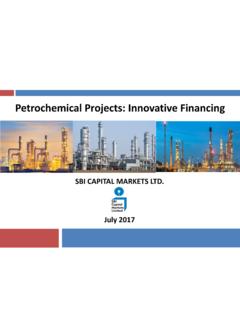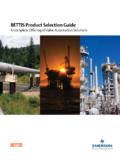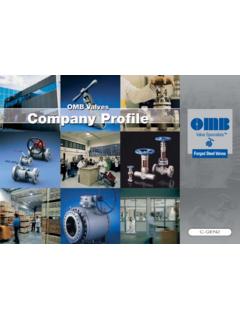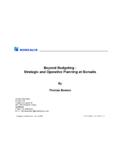Transcription of ISOCARP paper - Evolution of Industrial Landscape in ...
1 Diwakar Kaushik, Evolution of Industrial Landscape in singapore , 48th ISOCARP Congress 2012 1 Evolution of Industrial Landscape in singapore Diwakar Kaushik, JTC Corporation, singapore In a rapidly changing world, we cannot anticipate all our future needs. Our best laid plans will have to be modified and updated as new challenges emerge. Hence, JTC must remain dynamic and nimble, keeping an eye on business trends, and responding promptly to new threats and opportunities. Prime Minister Lee Hsien Loong (June 2008) Introduction Set up in 1968, JTC Corporation (JTC) s key task was to develop Jurong Industrial Estate into an integrated manufacturing hub. Jurong Industrial Estate was the centre of singapore s industrialization drive which provided jobs for the fast growing population and reduced singapore s reliance on entreport trade.
2 However, reclaiming crocodile-infested swamps in Jurong in the 1960s for factories that might not come to singapore was an act of faith. Many at that time considered it a foolhardy exercisei. A hilly, jungled area mostly covered by mangrove swamps who many called the lost region in the west of singapore , Jurong was selected as the location for the first Industrial estate of singapore . Its founding father, Dr Goh Keng Swee s vision for Jurong was to be the birthplace of large-scale industrialization in order to shift singapore s economy to higher gears. High unemployment combined with pressing needs to create a conducive environment for growth and investment resulted in unique solutions that were tailored to meet the needs of singapore .
3 Pre-independence, singapore s economy had been heavily dependent on the entreport trade and the then British expenditure at the naval bases on the Island. Post independence, a national drive towards industrialization was launched to promote economic growth. The objective was for jobs creation and was prompted by the growing awareness that singapore s labour force was growing faster than the expansion in the entreport trade. The administrators were faced with the twin task of creating maximum number of jobs in the shortest possible time to arrest the rising unemployment; and to achieve within the shortest possible time, the diversification of the economy. JTC s challenges were multifold and it was for this reason that JTC was tasked with the planning, development, leasing and management of Industrial estates in Singaporeii.
4 The 60 s In the 1960's, singapore attracted labour intensive industries and provided ready-built standard factories to facilitate speedy set-up for the companies. Economic growth and job creation was seen in quantitative terms in the number of jobs that could be created and the amount of foreign investment that could be earned due to this. Two distinct form of Industrial environments emerged during this time: (i) The first is that of well-planned large Industrial estates in the rural/suburban parts of the island: and (ii) The second form is that of planned light Industrial estates located close to high-density housing estates or at the fringe of the central area. Diwakar Kaushik, Evolution of Industrial Landscape in singapore , 48th ISOCARP Congress 2012 2 Figure 1: Designed for mass replication (Source: JTC) The 70 s - The 1970 s was in essence a continuation of the efforts of the 60 s to achieve sufficiency in terms of economic growth and eradicating unemployment.
5 Petroleum refineries and petrochemical industries were identified as key growth sectors to push the economy further and the offshore islands off Jurong Industrial Estate were identified to locate these companies. Figure 2: Essential and quality products (Source: JTC) The type of Industrial estates being developed took a different form: (iii) Industrial estates with clusters of industries like furniture and shipyards. The creation of such industries was also the result of government policies such as the relocation of pollutive industries from the water catchment areas. (iv) Setting up of workshop complexes to house smaller industries. Diwakar Kaushik, Evolution of Industrial Landscape in singapore , 48th ISOCARP Congress 2012 3 Figure 3: Landed factories(Source: JTC) The 1980 s The 80 s saw an Industrial restructuring program, the prime objective which was to develop singapore into a modern Industrial economy based on science, technology, skills and knowledge.
6 This saw a shift to capital and technology intensive industries with a better-trained work force and higher Industrial capabilities. To support and meet the needs of new businesses, the type of Industrial parks that evolved took a new dimension: (i) Upgrading and improvement of Industrial parks through new product creation; and (ii) Birth of Science Parks and later Business parks in singapore . These parks are set in high quality environments catering to the needs of modern businesses. To name a few, the singapore Science Park and the Tuas Biomedical Parks were two such ambitious master plans that were initiated to cater to high end knowledge based industries. Figure 4: Ramp up, Stack Up Factories Land scarcity + intensification (Source: JTC) Diwakar Kaushik, Evolution of Industrial Landscape in singapore , 48th ISOCARP Congress 2012 4 The 1990 s The birth of the information technology age saw many businesses moving up the value chain by intensifying their use of information and related new technologies.
7 Advancement in technology also meant addressing new business expectations, needs and demands and JTC had to find ways of keeping up with the rapid nature of evolving business needs. This period saw the organizations strategic shift to becoming more customers centric, business oriented and internationally driven. JTC was evolving to becoming a partner to businesses from its traditional role of being a land infrastructure provider. Figure 5: High Value add industries: Jurong Island (left) Changi Business Park (right) (Source: JTC) Figure 6: International Business park, 1992 (left) Changi Business Park, 1997 (right) (Source: JTC) Diwakar Kaushik, Evolution of Industrial Landscape in singapore , 48th ISOCARP Congress 2012 5 Land intensification: Reclamation, En-Bloc Redevelopment and Higher Plot Ratios The year 1991 saw singapore complete its concept master plan to determine the ultimate land bank required.
8 To ensure that land resources would be sufficient for future Industrial growth, policies and plans placed emphasis on both land preservation and land-use optimization. Accordingly, JTC implemented a major land acquisition programme to accumulate its land bank. On top of these changes, land reclamation works were also carried out on a much larger scale to increase the supply of Industrial land. Previously, land was reclaimed to create today s Jurong Industrial Estate in the 1960 s and 1970 s, including two sea channels for offshore and marine industries. From 1993 onwards, Jurong Island, singapore s chemical and energy hub located off the west coast, was created by amalgamating a cluster of seven separate islands through land reclamation works.
9 Iii In addition, under JTC s 1997 Industrial Plan for the 21st Century (IP21), policies were drawn up to maximize the Industrial land yield through intensification of Industrial land namely through higher plot ratios. For new companies, a satisfactory plot ratio of their building facility had to be fulfilled before granting the lease of land to them. Existing Industrial companies were encouraged to increase their plot ratio through incentives such as lease extension, and rules were reviewed to allow the return of under-utilized excess land with minimal cost, and to allow greater flexibility in subletting spaces held for future In addition, JTC set up the Redevelopment Group to carry out en-bloc redevelopment schemes for old estates identified as not optimally using the land, usually with very low plot ratios of less than The Group purchased back the unexpired tenure of leases and provided compensation packages to help these tenants relocate.
10 Besides rebuilding these low-rise factories to high plot ratios, the infrastructure and facilities of these estates were improved to match up to the needs of modern industries that the country was moving towards. These redeveloped units were then allocated to higher value-added companies that helped achieve higher land productivity compared to their former tenants. v JTC also sought pragmatic ways to work around the challenges of conventional Industrial operations. The stack-up factory was a new building typology that JTC came up with, designed to intensify land use by stacking the traditional standard factories on top of one another to create multi-storey factories. The use of ramps to gain access to upper levels allowed occupants to enjoy the same convenience as those at ground floor with regard to loading/unloading of goods.
